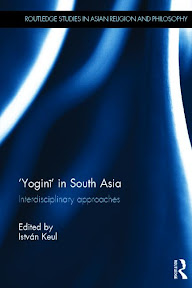Yogini in South Asia
Keul, István [Hrsg.]:
'Yoginī' in South Asia : Interdisciplinary Approaches / edited by István Keul. - London ; New York : Routledge, 2013. - xiii, 237 S. : Ill. - (Routledge Studies in Asian Religion and Philosophy ; 9)
ISBN 978-0-415-62522-7 (Print-Ausg.)
ISBN 978-0-203-36192-4 (eBook)
£ 85,00
DDC: 294.5436
Beschreibung
In different stages in the history of South Asian religions, the term yogini has been used in various contexts to designate various things: a female adept of yoga, a female tantric practitioner, a sorceress, a woman dedicated to a deity, or a certain category of female deities. This book brings together recent interdisciplinary perspectives on the medieval South Asian cults of the Yoginis, such as textual-philological, historical, art historical, indological, anthropological, ritual and terminological.
The book discusses the medieval yogini cult, as illustrated in early Saiva tantric texts, and their representations in South Asian temple iconography. It looks at the roles and hypostases of yoginis in contemporary religious traditions, as well as the transformations of yogini-related ritual practices. In addition, this book systematizes the multiple meanings, and proposes definitions of the concept and models for integrating the semantic fields of ‘yogini.’
Highlighting the importance of research from complementary disciplines for the exploration of complex themes in South Asian studies, this book is of interest to scholars of South Asian Studies and Religious Studies. [Verlagsinformation]
Herausgeber
ISTVÁN KEUL was Professor in the Study of Religions at the Norwegian University of Science and Technology, Norway. His main field of interest is South Asian religion, and he has previously published on the Hindu deity Hanuman.
Quellen: Routledge; WorldCat; Amazon (UK); Google Books (eBook); Library of Congress
Bildquelle: Routledge
Bibliographie: [1]
References
- (2013). Yoginī in South Asia: Interdisciplinary Approaches. Routledge Studies in Asian Religion and Philosophy; 9.
Ähnlich
- Tavaszi: Die Schicksalsgöttin des Harivaṃśa
- Leben in der Kraft der Rituale
- Wege zum Heil(igen)?
- Davis: The Bhagavad Gita
- Rao: Re-figuring the Rāmāyaṇa as Theology
- Oliver: Hinduism and the 1960s
- Purāṇas, History and Itihāsas
- Collins: The Head Beneath the Altar
- Okita: Hindu Theology in Early Modern South Asia
- Banāras Revisited

